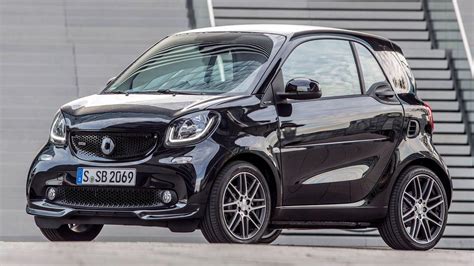Smart Fortwo coupe electric problems

The Smart EQ Fortwo, formerly Smart Fortwo electric drive, smart ed or Smart Fortwo EV, is a battery electric vehicle variant of the Smart Fortwo city car made by Smart. Since 2020, Smart is only selling battery EVs.
The Smart EQ Forfour was an electric variant of the long wheelbase four-door second generation Smart Forfour city car Type 453 which shared approximately 70% of its parts with the third-generation Renault Twingo, both built by Renault in Slovenia.
Field testing of the electric Smart Fortwo 450 began in London with 100 units in 2007, leasing only due to the cumbersome molten salt ZEBRA battery. With drive train and Lithium Ion battery provided by a California startup named Tesla, the second generation ED with the second generation 451 chassis was introduced in 2009 and made available in 18 markets around the world for leasing, or through the Car2Go carsharing service in selected cities, with over 2,300 units delivered.
A near production version of the third-generation Smart ED, using the face lift 451 body and drive train plus complete LiIon battery built by Daimler joint ventures, was unveiled at the September 2011 Frankfurt Motor Show. Smart started in 2012 to mass-produce the electric car for regular availability in up to 30 markets worldwide. Deliveries of the third-generation Smart ED began in the U.S. and Europe in May 2013. More than 8,800 units of the second and third generation Smart ED were sold in North America and Europe between 2009 and June 2014, of which, over 6,500 units are third generation variants.
Since 2017, the fourth-generation Smart Electric Drive is being sold. As Daimler discontinued the electric joint ventures, it uses a Renault drive train, the fourth variant in as many electric generations. The body corresponds to the third-generation ICE-powered Smart 453; this mismatch in the numbering of generations arose because the Smart ED2 and the Smart ED3 were both based on the second-generation ICE-powered Smart 451.

Social links
Smart Fortwo coupe electric model years


Common Smart Fortwo coupe electric problems
Based on complaints from owners of the Smart Fortwo Coupe Electric cars, common problems include:
- Interior Wear: The interior of the Smart Fortwo Coupe Electric is made of hard, scratchy plastics that are prone to scuffing, especially from shoes or jewelry. While these materials are easy to clean, they can show wear and tear quickly, impacting the overall look of the interior.
- Recall for Poorly Made Bolts: A significant problem reported by owners is related to poorly made bolts used to attach the steering gear. These bolts may not meet endurance requirements, leading to potential fractures. If these bolts break, it can impact vehicle handling, increasing the risk of an accident. Symptoms of this issue include unusual noises while driving, a tilted steering wheel position, and the ESP warning light coming on. This problem affects specific models of the Smart Fortwo Coupe, Convertible, and Electric produced in 2014 and 2015. The recall involves replacing the steering gear mounting bolts to address this safety concern.
These issues highlight some of the common problems faced by owners of the Smart Fortwo Coupe Electric cars, ranging from cosmetic concerns to more serious safety-related recalls.

What are the most common problems with a Smart Car?
17 Smart Common Problems They Don't Want Us To Know
- Anti-Brake System Problem.
- Clutch Malfunction.
- Quick-Wearing Brakes. ...
- Electrical Failures.
- Gears Slip Out of Place.
- Jerks in the Gearbox.
- Brakes Squealing and Grinding.
- Slipping & Grinding Clutch – Manuel Cars Only.
How long do electric smart cars last?
Typically, a Smart Car will survive 150,000-450,000 miles, providing an excellent ownership opportunity for buyers. The car can last for several decades with flawless maintenance, though most will get around two out of the system. If you're careful with the compact car, it will work well for your driving desires.
What is the life expectancy of a Smart Car battery?
In general, modern EV batteries are designed to be durable and long-lasting. The most commonly used EV batteries are lithium-ion (Li-ion) batteries, which can typically last between 8 to 15 years or more, depending on the specific battery chemistry and usage.
What are the weaknesses of a Smart Car?
Smart cars are typically only big enough to seat 2 people. This can be a real issue if you have a family of 4. Since they are not really geared towards families, this can be a decided disadvantage to owning one. Never mind the 20 trips you'd have to make to take your daughter's soccer team to practice!
Recalls Smart Fortwo coupe electric
The National Highway Traffic Safety Administration (NHTSA) has issued 1 recalls for different components of the Smart Fortwo coupe electric.You can explore the year of the Volkswagen Jetta you are interested in by selecting it from the list.
- Model: Smart Fortwo coupe electric 2014
- Report Received Date: 2015-03-31
- Manufacturer: Mercedes-Benz USA, LLC.
- Components: STEERING
- Summary: Mercedes-Benz USA, LLC (MBUSA) is recalling certain model year 2014-2015 Smart Fortwo Coupes and Convertibles, and 2014 Fortwo Coupe Electric and Fortwo Convertible Electric vehicles. The affected vehicles have steering gear mounting bolts which may break during vehicle operation.
- Consequence: If the steering gear mounting bolts break, vehicle handling could be affected, increasing the risk of a crash.
- Remedy: MBUSA will notify owners, and dealers will replace the steering gear mounting bolts, free of charge. The recall began on May 8, 2015. Owners may contact Smart customer service at 1-800-762-7887.
Are you having problems with your Smart Fortwo coupe electric?


